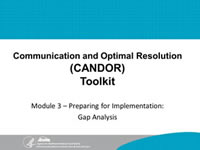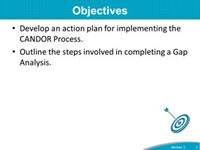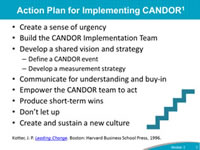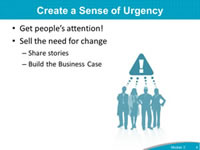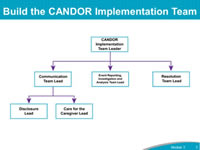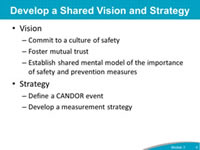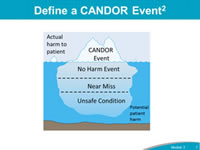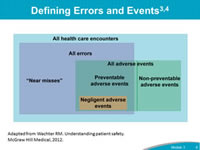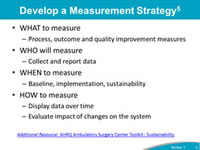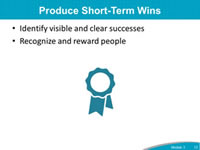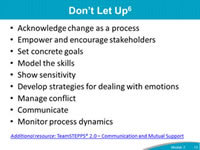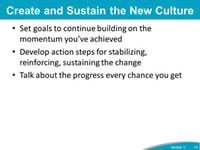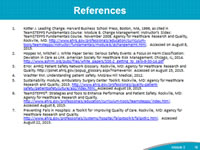Module 3: Preparing for Implementation: Gap Analysis
AHRQ Communication and Optimal Resolution Toolkit
Facilitator Notes
|
Say: Module 3 of the CANDOR Toolkit describes the critical steps to prepare an organization for successful implementation of the CANDOR process. The module also includes tools and resources that can help hospitals analyze gaps that may impact implementation of the CANDOR process. |
Slide 1
|
|
Say: At the end of this module, the learner will be able to:
|
Slide 2
|
|
Say: Creating a CANDOR process action plan is critical to the success and sustainability of the process. The steps for developing an action plan for CANDOR process implementation follow the steps for change outlined in John Kotter’s 8-Step Process for Leading Change model. Kotter’s model describes what must happen to achieve system-wide change. The steps for implementing a CANDOR action plan include:
We will discuss each of these steps in greater detail and provide additional tools to help prepare your organization for change. |
Slide 3
|
|
Say: The first step of implementing change is creating a sense of urgency around the need for change. Questions such as “Why are we implementing this change?” and “What is the benefit?” aid in connecting the change to specific outcomes. Unless people understand the urgency behind the CANDOR process, implementing the change becomes very difficult, if not impossible. Get people’s attention and make the case that this is the right time to implement the CANDOR process in the organization. Share stories and use the Building the Business Case for CANDOR Worksheet to help leaders and staff clearly see the value and need for implementing the CANDOR process. |
Slide 4
|
|
Say: The next step in implementing the CANDOR process is the identification of the CANDOR Implementation Team. For the change effort to be successful, a group must lead the change and work as a team to support the process. Key characteristics of team members should include: authority to lead the change, leadership skills, credibility, communications ability, expertise in change management, analytical skills, and a sense of urgency. See Module 2 for more information on obtaining senior leader, risk management, and staff buy-in and support for the CANDOR process. It is important to have representatives on the Implementation Team from across the organization to promote system-wide implementation of the process. The CANDOR Implementation Team structure is represented in this diagram. The Implementation Team is led by the CANDOR Implementation Team Leader; this should be a senior leader who is responsible for organization wide implementation of the CANDOR process. He or she is responsible for ensuring that individual team members have what they need to implement the steps they own in the CANDOR process. The Team Lead for each subgroup is responsible for overseeing the implementation of individual steps in the CANDOR process and reports to the CANDOR Implementation Team Leader. The three subgroups include:
|
Slide 5
|
|
Say: Once the CANDOR Implementation Team is formed, the next step is to develop a shared vision for implementing the CANDOR process in the organization. A key component of a shared vision for the CANDOR process is the commitment to a "culture of safety." An organization must demonstrate this commitment through its practices, processes, and procedures. The foundation of an organization’s culture of safety includes a focus on mutual trust and a shared mental model of the importance of safety and prevention measures. The CANDOR Implementation Team can help lead the development of this shared vision for the CANDOR process. Questions that can help guide the team through this discussion include: What is the organization’s current culture of safety? What is the reason or motivation for the CANDOR process being implemented now? How does the team’s vision align with the organization’s patient safety and quality goals? Once the team has established a vision, it’s important to discuss the change strategy, which includes defining a CANDOR event and developing a measurement strategy. These two sub-steps will be discussed further on the next few slides. |
Slide 6
|
|
Say: A CANDOR event is defined as an event that involves unexpected harm (physical, emotional, or financial) to a patient. These events trigger the CANDOR process even when causation is not yet known. It is important for an organization to use this definition as a starting point for how they will define a CANDOR event within their organization. The best practice for implementation of the CANDOR process in an organization is to tie this definition to the organization’s current harm rating system. During the initial launch of the CANDOR process at the pilot organizations, some organizations have found that limiting the definition of a CANDOR event so that the trigger for the CANDOR process was linked to only the more serious events allowed an organization to gradually build support for the new process. As the culture begins to change, the organization can start to expand the definition of a CANDOR event, thereby triggering the process for events of varying degrees of severity. |
Slide 7
|
|
Say: It is important to understand the distinction between events and errors when an organization is clarifying their definition of a CANDOR event. Errors are defined as an act of commission (doing something wrong) or omission (failing to do the right thing) that leads to an undesirable outcome or significant potential for such an outcome. An adverse event is "any injury caused by medical care" and doesn't imply "error," "negligence," or poor quality care. The diagram, developed by Robert Watcher, shows the distinction between adverse events and errors. Not all adverse events are medical errors and not all medical errors are adverse events. Do: Explain the diagram to others, and ask others to provide examples of adverse events that are not errors and errors that are not adverse events. |
Slide 8
|
|
Say: The next step in developing a change strategy is building a measurement system. The measurement system should include what data will be collected over time, who will collect the data, when the data will be analyzed and shared, and how the data will used to promote continuous learning and improvement. When developing a measurement system, include information in the plan that answers the questions: What, Who, When, and How:
For more information on building a measurement system, see the Sustainability module of AHRQ’s Ambulatory Surgery Center Toolkit. |
Slide 9
|
|
Say: Once the CANDOR Implementation Team has developed a shared vision and strategy for change, the team must communicate clearly and effectively to assure understanding across the organization. Failure to implement change is often the result of under-communicating or communicating poorly, leaving staff with a lack of clarity and inability to accept or support the vision and strategy. Leaders can use personal stories to help staff understand the background and reason for change. Other methods to communicate for understanding include creating "marketing" materials that reinforce the different parts of the CANDOR process, hosting ongoing special presentations that include why the change is being done, and sharing the "wins" realized as the change process is being implemented. Questions that can to frame this segment of work include: How does your organization normally communicate with staff? How do staff like to be communicated with? Who can be engaged in presenting content to ensure staff understanding and support? What existing communication channels can be used to disseminate information? By developing a multi-pronged strategy to communicate the vision, the organization can achieve success in reaching a shared understanding of the CANDOR process among all staff. |
Slide 10
|
|
Say: To be effective as a team, the CANDOR Implementation Team Leader must take steps that empower the CANDOR team to act. These steps include developing a shared sense of purpose that is aligned with the vision and goals of the CANDOR implementation process. Leaders must change the systems or structures that support the change vision, and then provide employee training that supports the skills and attitudes that promote CANDOR process implementation. Alignment of information systems and personnel with the vision and goals is another important component of assuring all staff are empowered to act on the desired changes. Once the staff have a clear understanding of the changes and expectations, the leaders must act to remove any obstacles to change. See Module 2 for more information on how senior leaders and risk management can engage and obtain staff support. |
Slide 11
|
|
Say: An important element of culture change is an organization’s ability to produce short-term wins. Small wins help the team and staff see that progress and change are possible. Leaders should, as early as possible, identify visible, clear successes that can be connected to the change effort. Once these successes are identified, it is important to recognize and reward people who contributed to the short-term wins. This reward and recognition will help encourage team members to continue to support the implementation process and will help sustain the effort in the future. |
Slide 12
|
|
Say: During implementation, the CANDOR team must not let up on the change process. Organizations should anticipate some resistance to change and understand it is possible to develop a plan to effectively address any resistance. By listening to and addressing the concerns of staff who are resistant to change, the organization can better understand the barriers and actually improve the change process. There are many ways to overcome resistance to change, and your team can adapt some or all of the following strategies to develop a plan that works best for your organization:
Implementing change is hard work, particularly when the change involves a response to an adverse patient event. The TeamSTEPPS 2.0 curriculum provides valuable resources and strategies to help teams improve communication and offer mutual support, especially when experiencing change. See TeamSTEPPS Module 3 (Communication) and Module 6 (Mutual Support) for more resources and tools to support resilience during change. |
Slide 13
|
|
Say: Long-term improvements in culture take time. Creating and sustaining the new culture requires discipline and focus during the startup phase and over time. After every win, analyze what contributed to the success and what needs to be improved. Set goals to continue building on the momentum you have achieved, and develop action steps for stabilizing, reinforcing, and sustaining the change. The values behind your organization’s vision for the CANDOR process must be demonstrated in the day-to-day work, so talk about the process every chance you get. Additional ideas that help build the new foundation for change include integrating the change ideals and values into the onboarding orientation of new staff, publicly recognizing key members of the team, and planning for turnover as leaders transition into other roles. These steps will ensure that the change is embedded into the overall culture of the organization and that the process is not viewed as a project or an initiative that is owned by one team. |
Slide 14
|
|
Say: An organization should conduct a Gap Analysis prior to implementing the CANDOR process to identify how well current processes, policies, and systems support the desired CANDOR process. The gap analysis can determine how well prepared the organization is to embark on significant culture change. The steps needed to conduct a Gap Analysis are outlined in the Gap Analysis Facilitator’s Guide. The guide provides strategies and sample templates to assist the CANDOR Implementation Team in conducting a comprehensive Gap Analysis. It also provides a Gap Analysis Report Template, which is designed to help the CANDOR Implementation Team prepare to present the results of the Gap Analysis to staff, administrators, and other stakeholders. Preparing your organization for change requires both the capability to make changes and the motivation to change. Motivation to change is likely to be strong and enduring if the change leaders at all levels of the organization have a clear understanding of the reason for the change and how everyone can contribute to the overall goals. Understanding staff concerns early in the change process is key to assuring support. The Gap Analysis is designed to help the CANDOR Implementation Team understand the challenges and concerns early in the implementation process. It will help the organization identify the resources and actions needed to successfully begin the implementation of the CANDOR process. Module 4 will provide detailed information on the first component of the CANDOR process, Event Reporting and Event Investigation and Analysis. |
Slide 15
|
|
References |
Slide 16
|




